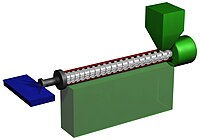
Photo from wikipedia
The paper presents a comparative analysis of two extrusion methods of biocomposites with a poly(3-hydroxybutyrate-co-3-hydroxyvalerate acid) (PHBV) matrix filled with flax and hemp fibers in terms of biopolymer production, its… Click to show full abstract
The paper presents a comparative analysis of two extrusion methods of biocomposites with a poly(3-hydroxybutyrate-co-3-hydroxyvalerate acid) (PHBV) matrix filled with flax and hemp fibers in terms of biopolymer production, its processing in the further injection process, and an evaluation of the mechanical and functional properties of the products. Biocomposites containing 15% by weight of the filler were produced using single- and twin-screw extruders. The biocomposites were then processed by injection molding and then, among other things, the pressures in the mold cavity during processing were analyzed. The produced samples were tested by means of the following tests: uniaxial tensile strength, hardness, and impact tensile strength. The biocomposite’s microstructure was also analyzed using scanning electron microscopy (SEM), as were the shrinkage and water absorption of the manufactured products. In addition, thermal gravimetric analysis (TGA) and differential scanning calorimetry (DSC) tests were performed. It was found that the extrusion method changed significantly the geometry of the filler fibers and the processing capabilities of the manufactured materials. Significant differences in the mechanical and functional properties of the obtained biocomposite products were also found. On their basis, the advantages and disadvantages of both extrusion methods were discussed. Most of the obtained properties of injection products indicate the choice of single-screw extrusion. The products were characterized by slightly better mechanical properties and lower processing shrinkage. In turn, composites obtained by the screw method were characterized by lower water absorption and lower viscosity of the composite during injection molding.
Journal Title: Polymers
Year Published: 2022
Link to full text (if available)
Share on Social Media: Sign Up to like & get
recommendations!